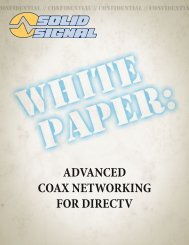TracVision DIRECTV Mobile Receiver/Controller User's Guide
TracVision DIRECTV Mobile Receiver/Controller User's Guide
TracVision DIRECTV Mobile Receiver/Controller User's Guide
- No tags were found...
Create successful ePaper yourself
Turn your PDF publications into a flip-book with our unique Google optimized e-Paper software.
<strong>DIRECTV</strong> <strong>Mobile</strong> <strong>Receiver</strong>/<strong>Controller</strong> User’s <strong>Guide</strong>Federal Communications Commission (FCC)Regulatory Information for Vehicle UseDeclaration of Conformity – Standards to which Conformity is declared:FCC Part 15This device complies with Part 15 of the FCC Rules. Operation is subjectto the following two conditions: (1) this device may not cause harmfulinterference, and (2) this device must accept any interference received,including interference that may cause undesired operation.Responsible Party’s Name: KVH Industries, Inc.Address: 50 Enterprise Center, Middletown, RI 02842Telephone: 1-401-847-3327Trade Name: KVHType of Equipment: Satellite <strong>Receiver</strong>Model Number: <strong>TracVision</strong> <strong>DIRECTV</strong> <strong>Mobile</strong> <strong>Receiver</strong>/<strong>Controller</strong>Federal Communications Commission (FCC) –This equipment complieswith Part 15 of the FCC rules.Part 15 Compliance – This equipment has been tested and found to complywith the limits for a Class B digital device, pursuant to Part 15 of the FCCrules. These limits are designed to provide reasonable protection againstharmful interference in a vehicle installation. This equipment generates, uses,and can radiate radio frequency energy and, if not installed and used inaccordance with the instructions, may cause harmful interference to radiocommunications.However there is no guarantee that interference will not occur in a particularinstallation. If this equipment does cause harmful interference to radio ortelevision reception, which can be determined by removing and applyingpower to the equipment, the user is encouraged to try to correct theinterference by one or more of the following measures:• Increase the separation between the equipment and thereceiver/controller.• Connect the equipment on a circuit different from that to which thereceiver/controller is connected.• Consult the dealer or an experienced auto electronics technician for help.The user may find the following booklet, prepared by the FederalCommunications Commission, helpful: “How to Identify and Resolve Radioand TV Interference Problems.” This booklet is available from the U.S.Government Printing Office, Washington, DC.To meet FCC requirements, only components certified to comply withClass B limits may be attached to this device. Operation with noncertifiedperipherals is likely to result in interference to radio and TV reception.To meet FCC requirements, shielded cables are required to connect thedevice to another Class B certified device.iv54-0376
















